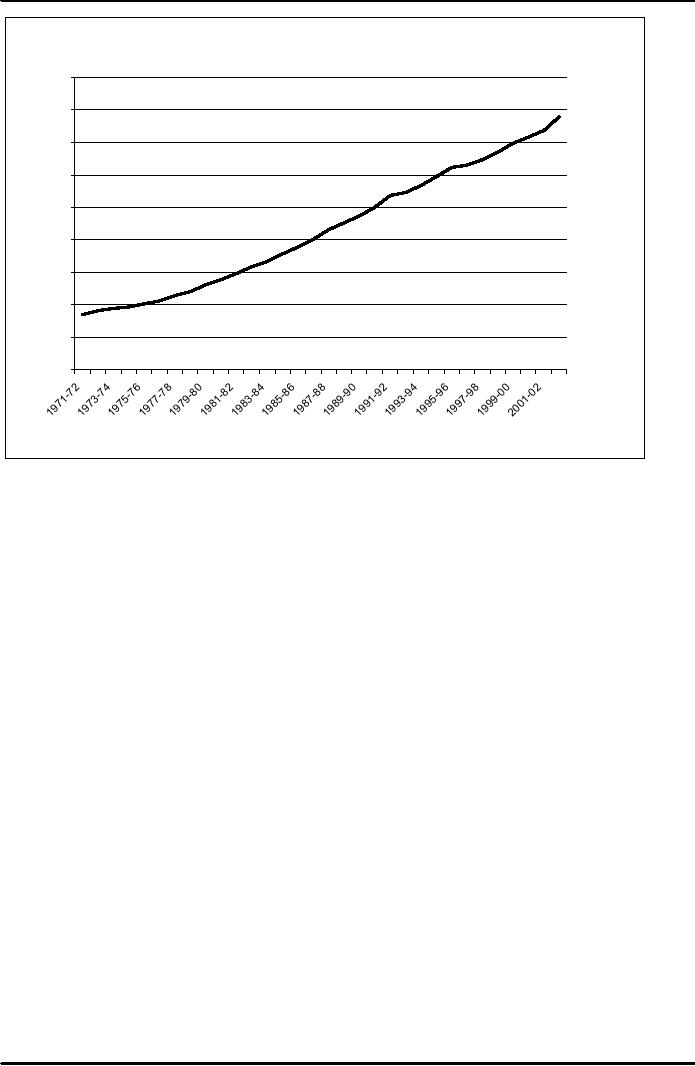 |
PRINCIPLE OF MACROECONOMICS:People Face Tradeoffs |
| << INTRODUCTION:COURSE DESCRIPTION, TEN PRINCIPLES OF ECONOMICS |
| IMPORTANCE OF MACROECONOMICS:Interest rates and rental payments >> |

Macroeconomics
ECO 403
VU
LESSON
02
PRINCIPLE
OF MACROECONOMICS
Principle
#1: People Face
Tradeoffs
"There
is no such thing as a free
lunch!"
To
get one thing, we usually
have to give up another
thing.
Guns v.
butter
Food v.
clothing
Leisure
time v. work
Efficiency
v. equity
Making
decisions requires trading
off one goal against
another.
Efficiency
v. Equity
�
Efficiency
means
society gets the most
that it can from its
scarce resources.
Equity
means
the benefits of those
resources are distributed
fairly among the
members
of society.
Principle
#2: Cost of Something Is
What You Give Up to Get
It
Decisions
require comparing costs and
benefits of alternatives.
�
Whether to
go to college or to work?
Whether to
study or go out on a
date?
Whether to
go to class or sleep
in?
The
opportunity
cost of an item is
what you give up to obtain
that item.
�
Principle
#3: Rational People Think at
the Margin
Marginal
changes are small,
incremental adjustments to an existing
plan of action.
�
People
make decisions by comparing
costs and benefits at the
margin.
Principle
#4: People Respond to
Incentives
Marginal
changes in costs or benefits
motivate people to
respond.
�
The
decision to choose one
alternative over another
occurs when that
alternative's
�
marginal
benefits exceed its marginal
costs!
Principle
#5: Trade Can Make
Everyone Better
Off
People
gain from their ability to
trade with one
another.
�
Competition
results in gains from
trading.
�
Trade
allows people to specialize in
what they do best.
�
Principle
#6: Markets are a good way
to organize economic
activity
A
market
economy is an economy
that allocates resources
through the
decentralized
�
decisions
of many firms and households
as they interact in markets
for goods and
services.
Households
decide what to buy and
who to work for.
Firms
decide who to hire and
what to produce.
Adam
Smith made the observation
that households and firms
interacting in markets
act
�
as
if guided by an "invisible
hand."
Because
households and firms look at
prices when deciding what to
buy and
sell,
they unknowingly take into
account the social costs of
their actions.
3

Macroeconomics
ECO 403
VU
As
a result, prices guide
decision makers to reach
outcomes that tend to
maximize
the welfare of society as a
whole.
Principle
#7: Governments can
sometimes improve market
outcomes
Market
failure occurs
when the market fails to
allocate resources
efficiently.
�
When
the market fails (breaks
down) government can
intervene to promote
efficiency
�
and
equity.
Market
failure may be caused
by
�
�
an
externality,
which is the impact of one
person or firm's actions on
the well-
being
of a bystander.
�
market
power,
which is the ability of a
single person or firm to
unduly influence
market
prices.
Principle
#8: The standard of living
depends on a country's
production
Almost
all variations in living
standards are explained by
differences in countries'
�
productivities.
Productivity
is
the amount of goods and
services produced from each
hour of a
�
worker's
time.
Standard
of living may be measured in
different ways:
�
�
By
comparing personal
incomes.
�
By
comparing the total market
value of a nation's
production.
Principle
#9: Prices rise when
the government prints too
much money
Inflation
is an increase in the overall
level of prices in the
economy.
�
One
cause of inflation is the
growth in the quantity of
money.
�
When
the government creates large
quantities of money, the
value of the money
falls.
�
Principle
#10: Society Faces a
Short-run Tradeoff Between
Inflation and
Unemployment.
The
Phillips Curve illustrates
the tradeoff between
inflation and
unemployment:
�
↓Inflation
↑Unemployment
It's
a short-run tradeoff!
Important
issues in macroeconomics
Why
does the cost of living
keep rising?
�
Why
are millions of people
unemployed, even when the
economy is booming?
�
Why
are there recessions?
�
Can
the government do anything to
combat recessions? Should
it??
What
is the government budget
deficit? How does it affect
the economy?
�
Why
do the economies have such a
huge trade deficit?
�
Why
are so many countries
poor?
�
What
policies might help them
grow out of poverty?
Gross
Domestic Product of
Pakistan
4

Macroeconomics
ECO 403
VU
GDP
at M arket Price (1980-81
Prices)
Rs
Millions
900,000
800,000
700,000
600,000
500,000
400,000
300,000
200,000
100,000
0
Years
5
Table of Contents:
- INTRODUCTION:COURSE DESCRIPTION, TEN PRINCIPLES OF ECONOMICS
- PRINCIPLE OF MACROECONOMICS:People Face Tradeoffs
- IMPORTANCE OF MACROECONOMICS:Interest rates and rental payments
- THE DATA OF MACROECONOMICS:Rules for computing GDP
- THE DATA OF MACROECONOMICS (Continued…):Components of Expenditures
- THE DATA OF MACROECONOMICS (Continued…):How to construct the CPI
- NATIONAL INCOME: WHERE IT COMES FROM AND WHERE IT GOES
- NATIONAL INCOME: WHERE IT COMES FROM AND WHERE IT GOES (Continued…)
- NATIONAL INCOME: WHERE IT COMES FROM AND WHERE IT GOES (Continued…)
- NATIONAL INCOME: WHERE IT COMES FROM AND WHERE IT GOES (Continued…)
- MONEY AND INFLATION:The Quantity Equation, Inflation and interest rates
- MONEY AND INFLATION (Continued…):Money demand and the nominal interest rate
- MONEY AND INFLATION (Continued…):Costs of expected inflation:
- MONEY AND INFLATION (Continued…):The Classical Dichotomy
- OPEN ECONOMY:Three experiments, The nominal exchange rate
- OPEN ECONOMY (Continued…):The Determinants of the Nominal Exchange Rate
- OPEN ECONOMY (Continued…):A first model of the natural rate
- ISSUES IN UNEMPLOYMENT:Public Policy and Job Search
- ECONOMIC GROWTH:THE SOLOW MODEL, Saving and investment
- ECONOMIC GROWTH (Continued…):The Steady State
- ECONOMIC GROWTH (Continued…):The Golden Rule Capital Stock
- ECONOMIC GROWTH (Continued…):The Golden Rule, Policies to promote growth
- ECONOMIC GROWTH (Continued…):Possible problems with industrial policy
- AGGREGATE DEMAND AND AGGREGATE SUPPLY:When prices are sticky
- AGGREGATE DEMAND AND AGGREGATE SUPPLY (Continued…):
- AGGREGATE DEMAND AND AGGREGATE SUPPLY (Continued…):
- AGGREGATE DEMAND AND AGGREGATE SUPPLY (Continued…)
- AGGREGATE DEMAND AND AGGREGATE SUPPLY (Continued…)
- AGGREGATE DEMAND AND AGGREGATE SUPPLY (Continued…)
- AGGREGATE DEMAND IN THE OPEN ECONOMY:Lessons about fiscal policy
- AGGREGATE DEMAND IN THE OPEN ECONOMY(Continued…):Fixed exchange rates
- AGGREGATE DEMAND IN THE OPEN ECONOMY (Continued…):Why income might not rise
- AGGREGATE SUPPLY:The sticky-price model
- AGGREGATE SUPPLY (Continued…):Deriving the Phillips Curve from SRAS
- GOVERNMENT DEBT:Permanent Debt, Floating Debt, Unfunded Debts
- GOVERNMENT DEBT (Continued…):Starting with too little capital,
- CONSUMPTION:Secular Stagnation and Simon Kuznets
- CONSUMPTION (Continued…):Consumer Preferences, Constraints on Borrowings
- CONSUMPTION (Continued…):The Life-cycle Consumption Function
- INVESTMENT:The Rental Price of Capital, The Cost of Capital
- INVESTMENT (Continued…):The Determinants of Investment
- INVESTMENT (Continued…):Financing Constraints, Residential Investment
- INVESTMENT (Continued…):Inventories and the Real Interest Rate
- MONEY:Money Supply, Fractional Reserve Banking,
- MONEY (Continued…):Three Instruments of Money Supply, Money Demand